外研版(2019)选择性必修第三册Unit 2 A life's work Understanding ideas 课件(共61张PPT)
文档属性
| 名称 | 外研版(2019)选择性必修第三册Unit 2 A life's work Understanding ideas 课件(共61张PPT) | 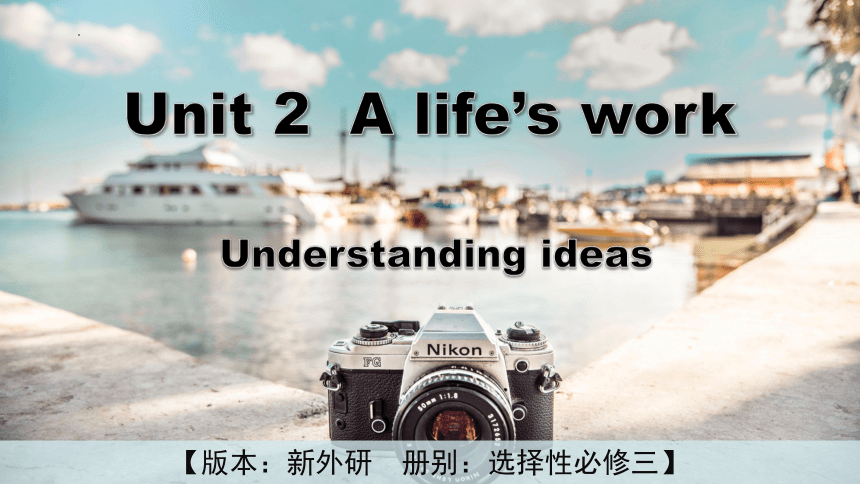 | |
| 格式 | pptx | ||
| 文件大小 | 24.0MB | ||
| 资源类型 | 教案 | ||
| 版本资源 | 外研版(2019) | ||
| 科目 | 英语 | ||
| 更新时间 | 2024-04-09 23:04:04 | ||
图片预览

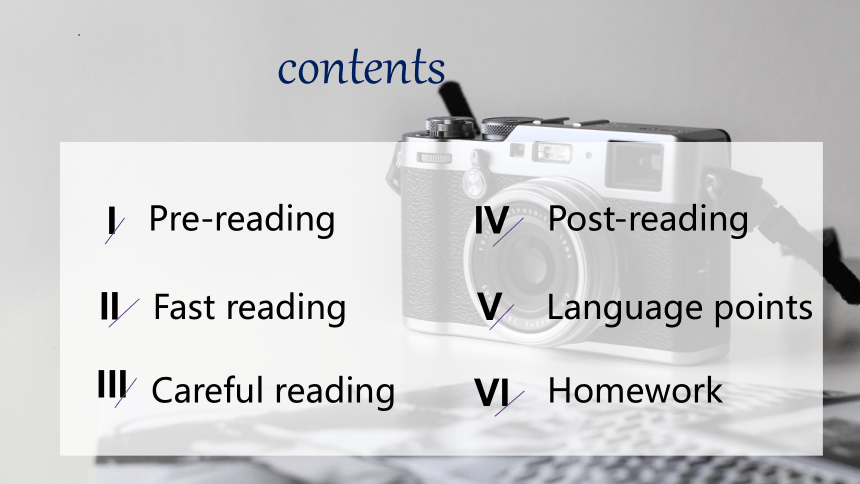

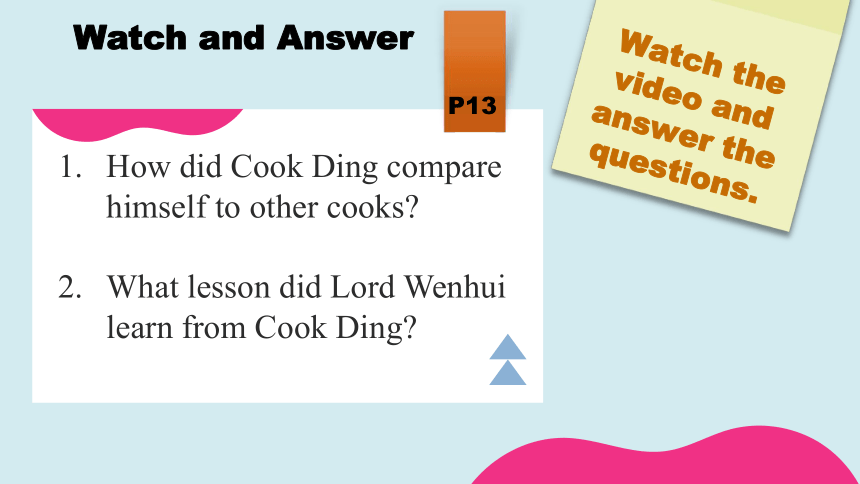

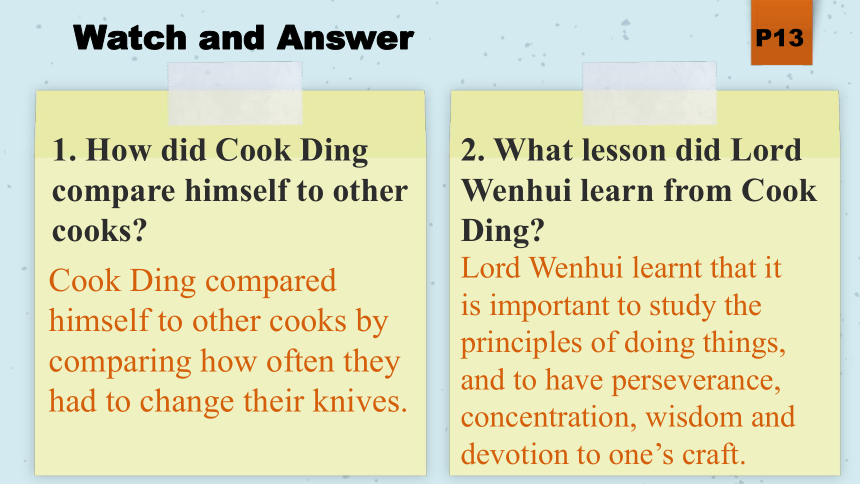

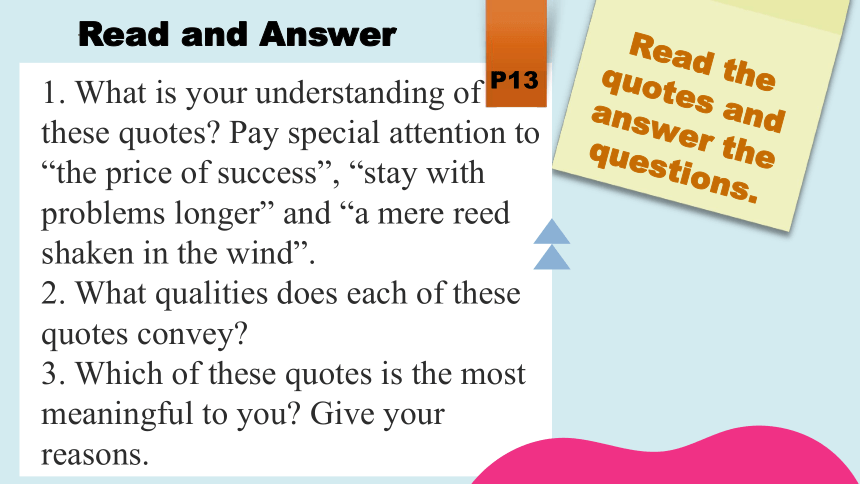
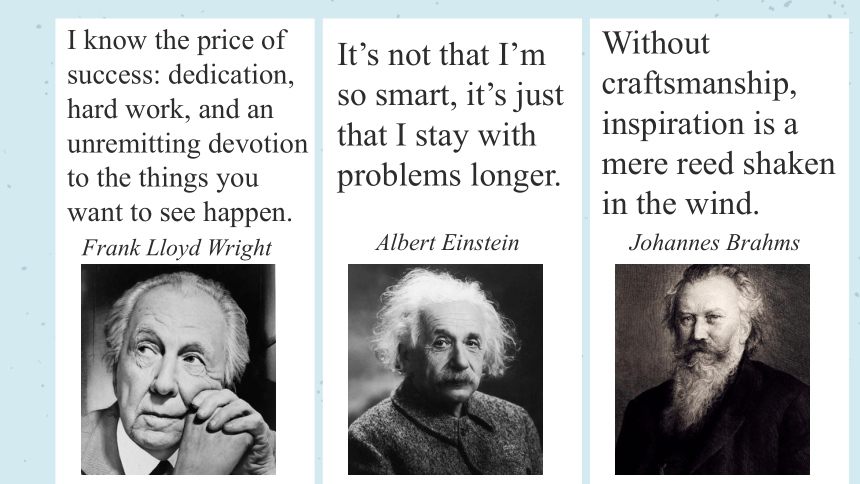
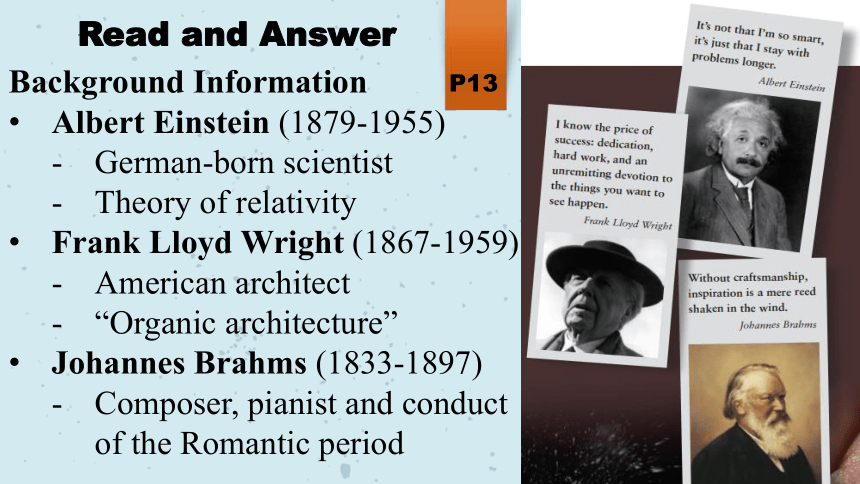
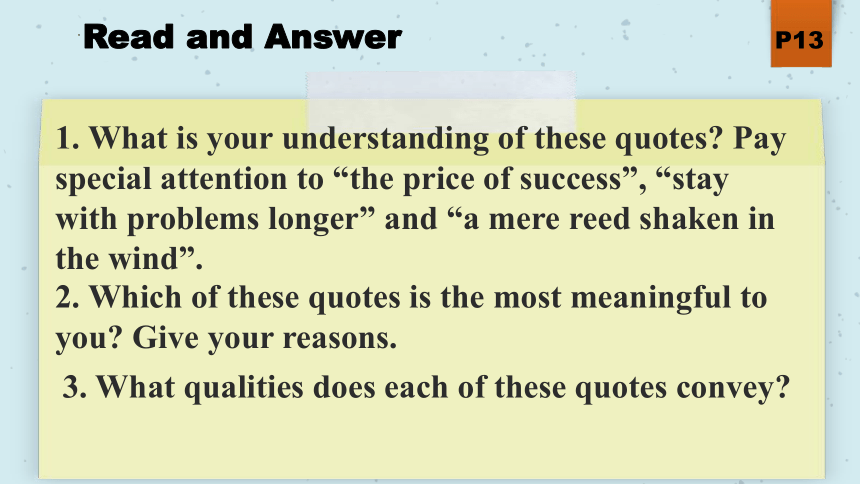
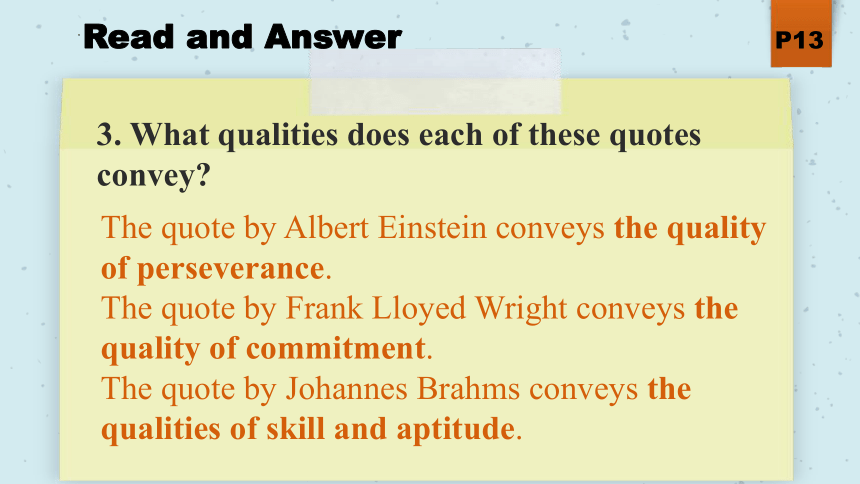
文档简介
(共61张PPT)
Unit 2 A life’s work
Understanding ideas
【版本:新外研 册别:选择性必修三】
Language points
Post-reading
Careful reading
Fast reading
Pre-reading
Homework
I
II
III
IV
V
VI
contents
Ⅰ
Pre-reading
How did Cook Ding compare himself to other cooks
What lesson did Lord Wenhui learn from Cook Ding
Watch the video and answer the questions.
Watch and Answer
P13
1. How did Cook Ding compare himself to other cooks
Cook Ding compared himself to other cooks by comparing how often they had to change their knives.
2. What lesson did Lord Wenhui learn from Cook Ding
Lord Wenhui learnt that it is important to study the principles of doing things, and to have perseverance, concentration, wisdom and devotion to one’s craft.
Watch and Answer
P13
From a Japanese word:
Shokunin
Kishitsu
工匠精神 “craftsman spirit”
1. What is your understanding of these quotes Pay special attention to “the price of success”, “stay with problems longer” and “a mere reed shaken in the wind”.
2. What qualities does each of these quotes convey
3. Which of these quotes is the most meaningful to you Give your reasons.
Read the quotes and answer the questions.
Read and Answer
P13
I know the price of success: dedication, hard work, and an unremitting devotion to the things you want to see happen.
Frank Lloyd Wright
It’s not that I’m so smart, it’s just that I stay with problems longer.
Albert Einstein
Without craftsmanship, inspiration is a mere reed shaken in the wind.
Johannes Brahms
Read and Answer
Background Information
Albert Einstein (1879-1955)
German-born scientist
Theory of relativity
Frank Lloyd Wright (1867-1959)
American architect
“Organic architecture”
Johannes Brahms (1833-1897)
Composer, pianist and conduct of the Romantic period
P13
1. What is your understanding of these quotes Pay special attention to “the price of success”, “stay with problems longer” and “a mere reed shaken in the wind”.
Read and Answer
2. Which of these quotes is the most meaningful to you Give your reasons.
P13
3. What qualities does each of these quotes convey
Read and Answer
3. What qualities does each of these quotes convey
The quote by Albert Einstein conveys the quality of perseverance.
The quote by Frank Lloyed Wright conveys the quality of commitment.
The quote by Johannes Brahms conveys the qualities of skill and aptitude.
P13
Look at the photos and answer the questions.
1. What differences are there between these two photographers
2. What do you think they each want to show through their works
3. What does the first picture tell you about the photographer
1. What differences are there between these two photographers
The photographer in the first picture is working on the street with a single, easy-to-carry camera.
The photographer in the second picture is working in a studio with
expensive, technologically-advanced
equipment.
Look at the photos and answer the questions.
2. What do you think they each want to show through their works
The photographer in the first picture may want to show the everyday life of ordinary people. The photographer in the second picture may want to show something prearranged about special groups in a studio.
Look at the photos and answer the questions.
3. What does the first picture tell you about the photographer
The first picture tells us about the photographer’s approach to his work and his interest in people’s day-to-day lives.
Look at the photos and answer the questions.
Bill Cunningham was an American fashion photographer famous for his candid photography, in particular that taken on the streets of New York.
Bill Cunningham
(1929-2016)
Background Information
A candid photograph is a photograph captured without creating a posed appearance.
As a fashion journalist in his early career, his photography caught the attention of an American newspaper, for which he reported from 1978 until his death in 2016.
Bill Cunningham
(1929-2016)
Background Information
Shunning material wealth (精简物质财富) throughout his long and successful life, Cunningham’s philosophy (人生哲学) was “If you don’t take their money, they can’t tell you what to do, kid.”
Bill Cunningham
Work
Background Information
1. According to the video and background information, what kinds of “craftsman spirits” can you find from Bill Cunningham
Read and Answer
P13
Ⅱ
Fast reading
Choose another suitable title for the passage and give your reasons.
1. Social Butterfly
2. Art and Devotion
3. Follower of Fashion
4. A Life in Photographs
Social Butterfly: someone who loves
to socialise and is outgoing and
charismatic.
Para 7: Cunningham’s passion for photography lasted throughout his life. He was 87 when he passed away, and had been working right up until his last illness.
Choose another suitable title for the passage and give your reasons.
Evidence
Para 4: what made Cunningham great was his devotion to photography, and the hours and hours of sheer hard work he put into his work.
Choose another suitable title for the passage and give your reasons.
Evidence
Choose another suitable title for the passage and give your reasons.
1. Social Butterfly
2. Art and Devotion
3. Follower of Fashion
4. A Life in Photographs
Appearance
Beliefs about fashion
Devotion to photography
Life philosophy
Views of wealth
Achievement
…
How many aspects of the article shape the character
Para.1
Para.3
Para.4
Para.5
Para.6
Para.7
III
Intensive reading
A white-haired old man riding an ordinary bicycle around the streets of New York, always wearing the same blue worker’s jacket and simple black running shoes. If you saw him, you’d never think there was anything remarkable about him. And yet every member of New York’s wealthy high society wanted nothing more than to pose for this man.
What is the daily look of Cunningham
Para.1
Read and Answer
A white-haired old man riding an ordinary bicycle around the streets of New York, always wearing the same blue worker’s jacket and simple black running shoes. If you saw him, you’d never think there was anything remarkable about him. And yet every member of New York’s wealthy high society wanted nothing more than to pose for this man.
What is the daily look of Cunningham
Para.1
Read and Answer
high society 上流社会,这里指上流社会的人
pose v. 使摆好姿势
pose for sb. 为某人摆好姿势
中文意思:“也不是因为他交友广泛,识人无数”
nor 意为“也不”。两个“it”都在回答段落首句的问题。
What made Cunningham so great It certainly wasn’t the use of expensive, technologially advanced equipment. Cunningham always used simple, relatively cheap cameras and took all his pictures on the streets of New York, not in a studio. Nor was it a wide range of contacts and connections.
Para.3
Read and Answer
Paraphrase
It was not a wide range of contacts and connections that made him so great, either.
Although he always knew where fashionable parties and events were happening, Cunningham liked to photograph ordinary people in the poor Bronx as much as VIPs in rich Manhattan. He found inspiration where others could not, in simple, everyday scenes, such as a man buying oranges at the local grocery store, or a woman riding home on the graffiti-covered subway. These things were real, and it was within their reality that Cunningham saw both beauty and potential. Through his fascination with what people were wearing, and not who they were, he opened the doors of fashion to everyone — fashion as he saw it belonged to the people, not just to high society and big brands.
Para.3
Read and Answer
What kinds of people did Cunningham prefer to photograph?
Real, ordinary people in simple, everyday scene.
Although he always knew where fashionable parties and events were happening, Cunningham liked to photograph ordinary people in the poor Bronx as much as VIPs in rich Manhattan. He found inspiration where others could not, in simple, everyday scenes, such as a man buying oranges at the local grocery store, or a woman riding home on the graffiti-covered subway. These things were real, and it was within their reality that Cunningham saw both beauty and potential. Through his fascination with what people were wearing, and not who they were, he opened the doors of fashion to everyone – fashion as he saw it belonged to the people, not just to high society and big brands.
Para.3
Read and Answer
Bronx n. 布朗克斯(纽约市“穷人区”)
VIP abbr. 大人物,贵宾(Very Important Person)
Manhattan n. 曼哈顿(纽约市“富人区”)
Graffiti-covered adj. 涂鸦覆盖的
big brands 大品牌,这里指奢侈品设计师品牌
grocery store n. 杂货店
AmE中,=supermarket
Although he always knew where fashionable parties and events were happening, Cunningham liked to photograph ordinary people in the poor Bronx as much as VIPs in rich Manhattan. He found inspiration where others could not, in simple, everyday scenes, such as a man buying oranges at the local grocery store, or a woman riding home on the graffiti-covered subway. These things were real, and it was within their reality that Cunningham saw both beauty and potential. Through his fascination with what people were wearing, and not who they were, he opened the doors of fashion to everyone – fashion as he saw it belonged to the people, not just to high society and big brands.
Para.3
Read and Answer
强调句型 It is / was ... + that / who ...
Paraphrase
It was because these things were real that Cunningham saw both beauty and potential in them.
Moreover, what made Cunningham great was his devotion to photography, and the hours and hours of sheer hard work he put into his work. Cunningham would go out onto the streets of New York each and every day, regardless of the weather. He would even stay outside in a storm, not coming back until he knew he had the right photos. He hardly ever
took a day off and not once stayed home sick. This devotion and hard work is what we see reflected within his photos. This is what makes them so special.
Read and Answer
Para.4
sheer adj. 纯粹;完全
complete and not mixed with anything else
take a day off 休假一天
stay home sick 生病在家休息
Cunningham never accepted the benefits offered to him for being a fashion photographer. He valued his integrity and
would not be bought by anyone, no matter how many free clothes or flights to faraway destinations he was offered. And if he went to a celebrity party, he was there to work rather than have fun. “Money’s the cheapest thing,” he once said, then added: “... freedom is the most expensive.” This lack of self-interest and promotion kept Cunningham focused on his craft, enabling him to capture New York’s unique street style.
Read and Answer
Para.6
self-interest n.利己主义; promotion n.晋升
celebrity party 名流聚会
celebrity [C]名人 [U]名望
Cunningham never accepted the benefits offered to him for being a fashion photographer. He valued his integrity and
would not be bought by anyone, no matter how many free clothes or flights to faraway destinations he was offered. And if he went to a celebrity party, he was there to work rather than have fun. “Money’s the cheapest thing,” he once said, then added: “... freedom is the most expensive.” This lack of self-interest and promotion kept Cunningham focused on his craft, enabling him to capture New York’s unique street style.
Read and Answer
Para.6
How do you understand the underlined sentences
They show Bill Cunningham’s different attitudes between money and freedom of creation.
Cunningham never accepted the benefits offered to him for being a fashion photographer. He valued his integrity and
would not be bought by anyone, no matter how many free clothes or flights to faraway destinations he was offered. And if he went to a celebrity party, he was there to work rather than have fun. “Money’s the cheapest thing,” he once said, then added: “... freedom is the most expensive.” This lack of self-interest and promotion kept Cunningham focused on his craft, enabling him to capture New York’s unique street style.
Read and Answer
Para.6
Translation
对自身利益和升迁毫不关注,这使坎宁安能够专注于自己的技能,捕捉到纽约独特的街头风格。
focus on “专注于” = focus upon
本句中 focused 用作形容词,意为“专心的,专注的”。
Cunningham’s passion for photography lasted throughout his life. He was 87 when he passed away, and had been working right up until his last illness. Nothing ever stopped him from getting the photo he wanted. His hard work made him more than a fashion photographer – he was a “cultural anthropologist”, who we can thank for recording the life of a whole city and its people over half a century. Bill Cunningham was an observer, and not one of the observed, a worker not a star — and this was how he wanted it.
Read and Answer
Para.7
Paraphrase
Bill Cunningham chose to work in his own way, observing others instead of being observed. He was a worker behind the camera, not a star in front of it.
本句使用了作比较的描写方法,突出了 Bill Cunningham 在日常生活中追求简朴的生活哲学与他事业成功的关系。
Cunningham’s passion for photography lasted throughout his life. He was 87 when he passed away, and had been working right up until his last illness. Nothing ever stopped him from getting the photo he wanted. His hard work made him more than a fashion photographer – he was a “cultural anthropologist”, who we can thank for recording the life of a whole city and its people over half a century. Bill Cunningham was an observer, and not one of the observed, a worker not a star – and this was how he wanted it.
Read and Answer
Para.7
cultural anthropologist adj. 文化人类学家
【背景知识】cultural anthropology 文化人类学
文化人类学是人类学(对于人类的全貌视野研究)的分支之一。这个学科分支将文化视为有意义的科学概念。
文化人类学家探讨人类的文化变异性,搜集观察结果,这往往透过名为田野调查工作的参与观察,并查看全球的经济与政治过程对地方文化的影响。
(wiki百科)
Organise information from the passage and complete the diagram.
P16
Organise information from the passage and complete the diagram.
Bill Cunningham
Beliefs about fashion
Fashion is not restricted to 1 ______________________.
It belongs to 2 ________________________________.
It is about what people are wearing, not 3 ___________.
high society and big brands
the people
who they are
P16
Devotion to photography
Regardless of the weather, he would 4 ____________
____________________________________________.
He wouldn’t come back until 5 _________________
___________________________________________.
He hardly ever 6 ____________________________
____________________________________________.
Bill Cunningham
go out onto
the streets of New York
he knew he had the right photos
took a day off and not once stayed home sick
Organise information from the passage and complete the diagram.
P16
Bill Cunningham
Life philosophy
He lived in 7 _________________________________.
He ate 8 ____________________________________.
He never accepted 9___________________________
__________________________________ and valued 10 __________________________________________.
a small apartment with a shared washroom
the same meal of sausages, eggs and coffee
the benefits offered to him for being a fashion photographer
his integrity and would not be bought by anyone
Organise information from the passage and complete the diagram.
P16
Now come up with five words or expressions to describe Bill Cunningham. Give your reasons.
principled
be of integrity
devoted / dedicated
hard-working
skillful
passionate
…
unworldly(不慕金钱的)
live simple and modestly
Ⅳ
Post-reading
We have known about Bill Cunningham and what he has done from the above parts. Now discuss with your partners to dig up more information.
Think and Share
If you were to write about Bill Cunningham, which would you choose
Think and Share
P16
1. Why is Bill Cunningham called a
“cultural anthropologist”
2. What can you learn from Bill
Cunningham Share your thoughts
with the class.
3. What text types have you learnt
about to help you describe people
By saying “Money’s the cheapest thing”, Bill Cunningham shows us that material things are nothing for him and that he is fascinated with what he is doing. He thinks freedom is the most expensive thing in the world.
1. What is your understanding of Bill Cunningham’s
words “Money’s the cheapest thing”
A possible answer
Bill Cunningham is called a “cultural anthropologist” because his photography captured and created an everlasting record of the life of New York and its people over half a century.
2. Why is Bill Cunningham called a “cultural
anthropologist”
A possible answer
His devotion to photography, his passion for photography, his perseverance, his integrity and his approach to life are all the things that we can learn from him.
3. What can you learn from Bill Cunningham
Share your thoughts with the class.
A possible answer
1)Narration / Narrative 记叙文/叙述类
2)Description / Descriptive 描写文/描述类
3)Exposition / Expository 说明文/说明类
4)Argument / Argumentative 议论文/议论类
4. What text types have you learnt about to help
you describe people If you were to write about
Bill Cunningham, which would you choose
Text types:
Language points
Ⅴ
The book is filled with remarkable insights.
这本书很有真知灼见。
1. remarkable adj. 非凡的,显著的,卓越的
Language points
The changes taking place in China is remarkable.
中国发生的变化是值得注意的。
近义词:extraordinary, wonderful, striking
Her sad looks reflected the thought passing through her mind.
2. reflect v.
The sunlight was reflected in the water.
Language points
① 反映;表现;显示
她忧戚的面容反映出她内心的思想。
日光由水面反射出来。
②反射
2. reflect v.
I often reflect on the beauty and complexity of life.
Language points
我经常思考人生的美丽与复杂。
③思考;深思
(常与 on / upon 连用)
1. nothing more than __________________
2. pose for __________________
3. as much as __________________
4. fascination with __________________
5. devotion to __________________
仅仅;只不过
为……摆好姿势
和……一样多
对……强烈着迷
对……的奉献精神
Language points
6. put ... into ___________________
7. regardless of ___________________
8. not once ___________________
9. approach to ___________________
10. passion for ___________________
不管;不顾
一次也不
……的方法/方式
投入;把……放进
对……的强烈爱好
Language points
VI
Homework
Homework
1. Summarize what you’ve learnt today;
2. Read the text again and again to retell it.
Thanks
Unit 2 A life’s work
Understanding ideas
【版本:新外研 册别:选择性必修三】
Language points
Post-reading
Careful reading
Fast reading
Pre-reading
Homework
I
II
III
IV
V
VI
contents
Ⅰ
Pre-reading
How did Cook Ding compare himself to other cooks
What lesson did Lord Wenhui learn from Cook Ding
Watch the video and answer the questions.
Watch and Answer
P13
1. How did Cook Ding compare himself to other cooks
Cook Ding compared himself to other cooks by comparing how often they had to change their knives.
2. What lesson did Lord Wenhui learn from Cook Ding
Lord Wenhui learnt that it is important to study the principles of doing things, and to have perseverance, concentration, wisdom and devotion to one’s craft.
Watch and Answer
P13
From a Japanese word:
Shokunin
Kishitsu
工匠精神 “craftsman spirit”
1. What is your understanding of these quotes Pay special attention to “the price of success”, “stay with problems longer” and “a mere reed shaken in the wind”.
2. What qualities does each of these quotes convey
3. Which of these quotes is the most meaningful to you Give your reasons.
Read the quotes and answer the questions.
Read and Answer
P13
I know the price of success: dedication, hard work, and an unremitting devotion to the things you want to see happen.
Frank Lloyd Wright
It’s not that I’m so smart, it’s just that I stay with problems longer.
Albert Einstein
Without craftsmanship, inspiration is a mere reed shaken in the wind.
Johannes Brahms
Read and Answer
Background Information
Albert Einstein (1879-1955)
German-born scientist
Theory of relativity
Frank Lloyd Wright (1867-1959)
American architect
“Organic architecture”
Johannes Brahms (1833-1897)
Composer, pianist and conduct of the Romantic period
P13
1. What is your understanding of these quotes Pay special attention to “the price of success”, “stay with problems longer” and “a mere reed shaken in the wind”.
Read and Answer
2. Which of these quotes is the most meaningful to you Give your reasons.
P13
3. What qualities does each of these quotes convey
Read and Answer
3. What qualities does each of these quotes convey
The quote by Albert Einstein conveys the quality of perseverance.
The quote by Frank Lloyed Wright conveys the quality of commitment.
The quote by Johannes Brahms conveys the qualities of skill and aptitude.
P13
Look at the photos and answer the questions.
1. What differences are there between these two photographers
2. What do you think they each want to show through their works
3. What does the first picture tell you about the photographer
1. What differences are there between these two photographers
The photographer in the first picture is working on the street with a single, easy-to-carry camera.
The photographer in the second picture is working in a studio with
expensive, technologically-advanced
equipment.
Look at the photos and answer the questions.
2. What do you think they each want to show through their works
The photographer in the first picture may want to show the everyday life of ordinary people. The photographer in the second picture may want to show something prearranged about special groups in a studio.
Look at the photos and answer the questions.
3. What does the first picture tell you about the photographer
The first picture tells us about the photographer’s approach to his work and his interest in people’s day-to-day lives.
Look at the photos and answer the questions.
Bill Cunningham was an American fashion photographer famous for his candid photography, in particular that taken on the streets of New York.
Bill Cunningham
(1929-2016)
Background Information
A candid photograph is a photograph captured without creating a posed appearance.
As a fashion journalist in his early career, his photography caught the attention of an American newspaper, for which he reported from 1978 until his death in 2016.
Bill Cunningham
(1929-2016)
Background Information
Shunning material wealth (精简物质财富) throughout his long and successful life, Cunningham’s philosophy (人生哲学) was “If you don’t take their money, they can’t tell you what to do, kid.”
Bill Cunningham
Work
Background Information
1. According to the video and background information, what kinds of “craftsman spirits” can you find from Bill Cunningham
Read and Answer
P13
Ⅱ
Fast reading
Choose another suitable title for the passage and give your reasons.
1. Social Butterfly
2. Art and Devotion
3. Follower of Fashion
4. A Life in Photographs
Social Butterfly: someone who loves
to socialise and is outgoing and
charismatic.
Para 7: Cunningham’s passion for photography lasted throughout his life. He was 87 when he passed away, and had been working right up until his last illness.
Choose another suitable title for the passage and give your reasons.
Evidence
Para 4: what made Cunningham great was his devotion to photography, and the hours and hours of sheer hard work he put into his work.
Choose another suitable title for the passage and give your reasons.
Evidence
Choose another suitable title for the passage and give your reasons.
1. Social Butterfly
2. Art and Devotion
3. Follower of Fashion
4. A Life in Photographs
Appearance
Beliefs about fashion
Devotion to photography
Life philosophy
Views of wealth
Achievement
…
How many aspects of the article shape the character
Para.1
Para.3
Para.4
Para.5
Para.6
Para.7
III
Intensive reading
A white-haired old man riding an ordinary bicycle around the streets of New York, always wearing the same blue worker’s jacket and simple black running shoes. If you saw him, you’d never think there was anything remarkable about him. And yet every member of New York’s wealthy high society wanted nothing more than to pose for this man.
What is the daily look of Cunningham
Para.1
Read and Answer
A white-haired old man riding an ordinary bicycle around the streets of New York, always wearing the same blue worker’s jacket and simple black running shoes. If you saw him, you’d never think there was anything remarkable about him. And yet every member of New York’s wealthy high society wanted nothing more than to pose for this man.
What is the daily look of Cunningham
Para.1
Read and Answer
high society 上流社会,这里指上流社会的人
pose v. 使摆好姿势
pose for sb. 为某人摆好姿势
中文意思:“也不是因为他交友广泛,识人无数”
nor 意为“也不”。两个“it”都在回答段落首句的问题。
What made Cunningham so great It certainly wasn’t the use of expensive, technologially advanced equipment. Cunningham always used simple, relatively cheap cameras and took all his pictures on the streets of New York, not in a studio. Nor was it a wide range of contacts and connections.
Para.3
Read and Answer
Paraphrase
It was not a wide range of contacts and connections that made him so great, either.
Although he always knew where fashionable parties and events were happening, Cunningham liked to photograph ordinary people in the poor Bronx as much as VIPs in rich Manhattan. He found inspiration where others could not, in simple, everyday scenes, such as a man buying oranges at the local grocery store, or a woman riding home on the graffiti-covered subway. These things were real, and it was within their reality that Cunningham saw both beauty and potential. Through his fascination with what people were wearing, and not who they were, he opened the doors of fashion to everyone — fashion as he saw it belonged to the people, not just to high society and big brands.
Para.3
Read and Answer
What kinds of people did Cunningham prefer to photograph?
Real, ordinary people in simple, everyday scene.
Although he always knew where fashionable parties and events were happening, Cunningham liked to photograph ordinary people in the poor Bronx as much as VIPs in rich Manhattan. He found inspiration where others could not, in simple, everyday scenes, such as a man buying oranges at the local grocery store, or a woman riding home on the graffiti-covered subway. These things were real, and it was within their reality that Cunningham saw both beauty and potential. Through his fascination with what people were wearing, and not who they were, he opened the doors of fashion to everyone – fashion as he saw it belonged to the people, not just to high society and big brands.
Para.3
Read and Answer
Bronx n. 布朗克斯(纽约市“穷人区”)
VIP abbr. 大人物,贵宾(Very Important Person)
Manhattan n. 曼哈顿(纽约市“富人区”)
Graffiti-covered adj. 涂鸦覆盖的
big brands 大品牌,这里指奢侈品设计师品牌
grocery store n. 杂货店
AmE中,=supermarket
Although he always knew where fashionable parties and events were happening, Cunningham liked to photograph ordinary people in the poor Bronx as much as VIPs in rich Manhattan. He found inspiration where others could not, in simple, everyday scenes, such as a man buying oranges at the local grocery store, or a woman riding home on the graffiti-covered subway. These things were real, and it was within their reality that Cunningham saw both beauty and potential. Through his fascination with what people were wearing, and not who they were, he opened the doors of fashion to everyone – fashion as he saw it belonged to the people, not just to high society and big brands.
Para.3
Read and Answer
强调句型 It is / was ... + that / who ...
Paraphrase
It was because these things were real that Cunningham saw both beauty and potential in them.
Moreover, what made Cunningham great was his devotion to photography, and the hours and hours of sheer hard work he put into his work. Cunningham would go out onto the streets of New York each and every day, regardless of the weather. He would even stay outside in a storm, not coming back until he knew he had the right photos. He hardly ever
took a day off and not once stayed home sick. This devotion and hard work is what we see reflected within his photos. This is what makes them so special.
Read and Answer
Para.4
sheer adj. 纯粹;完全
complete and not mixed with anything else
take a day off 休假一天
stay home sick 生病在家休息
Cunningham never accepted the benefits offered to him for being a fashion photographer. He valued his integrity and
would not be bought by anyone, no matter how many free clothes or flights to faraway destinations he was offered. And if he went to a celebrity party, he was there to work rather than have fun. “Money’s the cheapest thing,” he once said, then added: “... freedom is the most expensive.” This lack of self-interest and promotion kept Cunningham focused on his craft, enabling him to capture New York’s unique street style.
Read and Answer
Para.6
self-interest n.利己主义; promotion n.晋升
celebrity party 名流聚会
celebrity [C]名人 [U]名望
Cunningham never accepted the benefits offered to him for being a fashion photographer. He valued his integrity and
would not be bought by anyone, no matter how many free clothes or flights to faraway destinations he was offered. And if he went to a celebrity party, he was there to work rather than have fun. “Money’s the cheapest thing,” he once said, then added: “... freedom is the most expensive.” This lack of self-interest and promotion kept Cunningham focused on his craft, enabling him to capture New York’s unique street style.
Read and Answer
Para.6
How do you understand the underlined sentences
They show Bill Cunningham’s different attitudes between money and freedom of creation.
Cunningham never accepted the benefits offered to him for being a fashion photographer. He valued his integrity and
would not be bought by anyone, no matter how many free clothes or flights to faraway destinations he was offered. And if he went to a celebrity party, he was there to work rather than have fun. “Money’s the cheapest thing,” he once said, then added: “... freedom is the most expensive.” This lack of self-interest and promotion kept Cunningham focused on his craft, enabling him to capture New York’s unique street style.
Read and Answer
Para.6
Translation
对自身利益和升迁毫不关注,这使坎宁安能够专注于自己的技能,捕捉到纽约独特的街头风格。
focus on “专注于” = focus upon
本句中 focused 用作形容词,意为“专心的,专注的”。
Cunningham’s passion for photography lasted throughout his life. He was 87 when he passed away, and had been working right up until his last illness. Nothing ever stopped him from getting the photo he wanted. His hard work made him more than a fashion photographer – he was a “cultural anthropologist”, who we can thank for recording the life of a whole city and its people over half a century. Bill Cunningham was an observer, and not one of the observed, a worker not a star — and this was how he wanted it.
Read and Answer
Para.7
Paraphrase
Bill Cunningham chose to work in his own way, observing others instead of being observed. He was a worker behind the camera, not a star in front of it.
本句使用了作比较的描写方法,突出了 Bill Cunningham 在日常生活中追求简朴的生活哲学与他事业成功的关系。
Cunningham’s passion for photography lasted throughout his life. He was 87 when he passed away, and had been working right up until his last illness. Nothing ever stopped him from getting the photo he wanted. His hard work made him more than a fashion photographer – he was a “cultural anthropologist”, who we can thank for recording the life of a whole city and its people over half a century. Bill Cunningham was an observer, and not one of the observed, a worker not a star – and this was how he wanted it.
Read and Answer
Para.7
cultural anthropologist adj. 文化人类学家
【背景知识】cultural anthropology 文化人类学
文化人类学是人类学(对于人类的全貌视野研究)的分支之一。这个学科分支将文化视为有意义的科学概念。
文化人类学家探讨人类的文化变异性,搜集观察结果,这往往透过名为田野调查工作的参与观察,并查看全球的经济与政治过程对地方文化的影响。
(wiki百科)
Organise information from the passage and complete the diagram.
P16
Organise information from the passage and complete the diagram.
Bill Cunningham
Beliefs about fashion
Fashion is not restricted to 1 ______________________.
It belongs to 2 ________________________________.
It is about what people are wearing, not 3 ___________.
high society and big brands
the people
who they are
P16
Devotion to photography
Regardless of the weather, he would 4 ____________
____________________________________________.
He wouldn’t come back until 5 _________________
___________________________________________.
He hardly ever 6 ____________________________
____________________________________________.
Bill Cunningham
go out onto
the streets of New York
he knew he had the right photos
took a day off and not once stayed home sick
Organise information from the passage and complete the diagram.
P16
Bill Cunningham
Life philosophy
He lived in 7 _________________________________.
He ate 8 ____________________________________.
He never accepted 9___________________________
__________________________________ and valued 10 __________________________________________.
a small apartment with a shared washroom
the same meal of sausages, eggs and coffee
the benefits offered to him for being a fashion photographer
his integrity and would not be bought by anyone
Organise information from the passage and complete the diagram.
P16
Now come up with five words or expressions to describe Bill Cunningham. Give your reasons.
principled
be of integrity
devoted / dedicated
hard-working
skillful
passionate
…
unworldly(不慕金钱的)
live simple and modestly
Ⅳ
Post-reading
We have known about Bill Cunningham and what he has done from the above parts. Now discuss with your partners to dig up more information.
Think and Share
If you were to write about Bill Cunningham, which would you choose
Think and Share
P16
1. Why is Bill Cunningham called a
“cultural anthropologist”
2. What can you learn from Bill
Cunningham Share your thoughts
with the class.
3. What text types have you learnt
about to help you describe people
By saying “Money’s the cheapest thing”, Bill Cunningham shows us that material things are nothing for him and that he is fascinated with what he is doing. He thinks freedom is the most expensive thing in the world.
1. What is your understanding of Bill Cunningham’s
words “Money’s the cheapest thing”
A possible answer
Bill Cunningham is called a “cultural anthropologist” because his photography captured and created an everlasting record of the life of New York and its people over half a century.
2. Why is Bill Cunningham called a “cultural
anthropologist”
A possible answer
His devotion to photography, his passion for photography, his perseverance, his integrity and his approach to life are all the things that we can learn from him.
3. What can you learn from Bill Cunningham
Share your thoughts with the class.
A possible answer
1)Narration / Narrative 记叙文/叙述类
2)Description / Descriptive 描写文/描述类
3)Exposition / Expository 说明文/说明类
4)Argument / Argumentative 议论文/议论类
4. What text types have you learnt about to help
you describe people If you were to write about
Bill Cunningham, which would you choose
Text types:
Language points
Ⅴ
The book is filled with remarkable insights.
这本书很有真知灼见。
1. remarkable adj. 非凡的,显著的,卓越的
Language points
The changes taking place in China is remarkable.
中国发生的变化是值得注意的。
近义词:extraordinary, wonderful, striking
Her sad looks reflected the thought passing through her mind.
2. reflect v.
The sunlight was reflected in the water.
Language points
① 反映;表现;显示
她忧戚的面容反映出她内心的思想。
日光由水面反射出来。
②反射
2. reflect v.
I often reflect on the beauty and complexity of life.
Language points
我经常思考人生的美丽与复杂。
③思考;深思
(常与 on / upon 连用)
1. nothing more than __________________
2. pose for __________________
3. as much as __________________
4. fascination with __________________
5. devotion to __________________
仅仅;只不过
为……摆好姿势
和……一样多
对……强烈着迷
对……的奉献精神
Language points
6. put ... into ___________________
7. regardless of ___________________
8. not once ___________________
9. approach to ___________________
10. passion for ___________________
不管;不顾
一次也不
……的方法/方式
投入;把……放进
对……的强烈爱好
Language points
VI
Homework
Homework
1. Summarize what you’ve learnt today;
2. Read the text again and again to retell it.
Thanks
